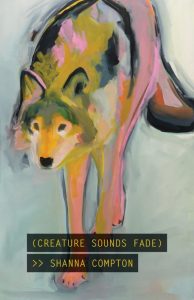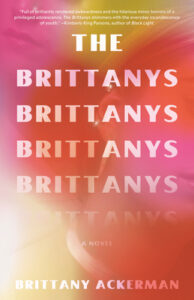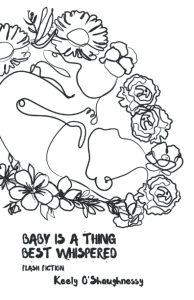Poetry. 90 pgs. Black Lawrence Press. November 2020. ISBN: 978-1-62557-816-7.
In a collection that is two parts feral eco-poetry, and one part stingingly personal reflection, New Jersey writer Shanna Compton uses re-engineered punctuation as the soundtrack to her crucial work. Here, the woods and the animals do not merely appear as backdrops and extras, they are creatures in coexistence with the speaker, sometimes mingling until the narrative voice and the wilderness are indistinguishable from one another. Compton is known in the literary community as the founding editor of micro-press Bloof Books, with striking design work under her belt for presses such as Barrelhouse Booksand Black Square Editions. This is her fourth collection of poetry, the others being Brink, For Girls Other Poems, and Down Spooky, the latter being the winner of the Winnow Press Open Poetry Award in 2005.
From the cover of (CREATURE SOUNDS FADE) which features a touchably pastelled wolf from LA artist Kimberly Kimbro, to the titular poem which closes the book, wildlife is in its various forms is starkly present. Compton uses parenthetical phrases to capture noises found in nature, often onomatopoeic in their language, and builds on this gauze of sound. Many of these poems are woven together by these parentheticals such as, “(WIND SCUFFING)”, “(COOING QUAILS)”, and my personal favorite “(CHIRP)”.
These poems insist themselves upon the reader as a work of ecocriticism. In some places that lens is explored through decadent extended metaphor, serving to disguise or somewhat mute these environmental concerns. In “Example Sentences”, Compton writes:
(ONLY-BIRDS SILENCE.) Only trees.
The autumn olive bushes around me
in the breakthrough sun exhaled, sweet and high
Like no creature on earth is able. (10)
Though the last line here posits a memorable suffocation brought about by the earth, the rest serves to personify nature in a delicate, sensory fashion, as well as bringing in some of the parentheticals that are part and parcel of this work.
In other pieces though, she is far more frank, indicting the reader and sometimes her own speaker: “You’re an age/that must come to pass/the heating & cooling of the plates” (95-96).
Compton is clearly motivated by this environmental anxiety, her words harkening back to that of canonical conservationists such as Gifford Pinchot who said that “conservation means the wise use of the earth and its resources for the lasting good of men” (Breaking New Ground 505). There is a threat here posed toward the human speaker and their like-people, but also back at the earth itself – while both continue on, both are at risk, tangibly and irrevocably linked.
Compton’s poems tell us as much about the human condition as they do about the planet’s resources. There is a threading through of a central romantic relationship, which culminates or takes root in the six-page poem “White Chrysanthemums,” where Compton’s speaker is confronted by her lover, who has read the diaries of her life and is partly intrigued and partly incensed with jealousy. Humanly, she remarks:
After that there was no chance I’d let him go:
he knew too much and I’d learned a different kind of fear:
not that of being revealed or judged but of the relief
I felt at being exposed. Oh vomitous intimacy!” (74)
Her language is plain and clear here – free from metaphor and achingly direct. Though relatability certainly shouldn’t be seen as a cornerstone of a good poetry collection, Compton manages to be both wildly inventive with her language throughout, before coming down to the very earth she writes about in moments like these.
In other places, relationships are harnessed in imagery that fits pleasingly into the landscape of the book. People are creatures themselves for Compton; their bodies are made sense of by the nature that surrounds and sustains them. In “Brood VIII”, she writes:
Your creature catches the scent of mine.
Both tremble, glossy carapaces
suspended in this dulcet vista
so ripe it looks painted on. (23)
The sibilance here is particularly striking, and sonically, every choice counts – there is not a single word that steps out of the poem’s field of language, and the reader is left beguiled by the depiction of these creatures romping together in the leaves.
Yes, Compton must be commended for her rhythmic imagery too – readers may well stop mid-poem upon reading this piece, its title doubling as its opening line:
I’d rather stay here & argue
about nothing the way
we flick it back & forth a netless game (27)
It’s rare to see such a fresh metaphor for this kind of ordinary moment, calling to mind the work of poets like Ada Limón, and giving new strength to the relationship which develops through these pages. Here, the use of white space mimics the content of the poem, both layering, and peeling back simultaneously – her employment of caesura is effortless throughout the collection. Most of Compton’s pieces are brief, no more than a page, and there is a conciseness and spareness to her mix of language and rhythm.
Finally, a piece that propels the reader forward with white space, but also works closely with the ecocritical themes of this collection is “Where the wall meets the river”. This poem is a critique of the speakers’ fellow man and balances a parabolic tone with a clear sense of irony found often in contemporary eco writings. The river plays a significant role in many of the poems in (CREATURE SOUNDS FADE), and here it represents the damage inflicted upon nature by humans:
Where the wall meets the river
the neighbors who begged it built are astonished
they can no longer see the river
taste it sweeten it for the fever child
where the wall meets the river
the neighbors cease to be neighbors (59)
In Compton’s work, there is a clear understanding that the land, and those who live upon it, must learn to coexist in some way. Compton doesn’t claim to have the answers – her speaker(s) are often fractured and flawed even while they are earnest and moving. Readers of Camille Dungy, or Mary Oliver fans looking for something with teeth, will find this collection vital to their bookshelves. While Compton seems to implore readers to take action in some places, there is a sense of hope to be found and nurtured in these pages. Near the close of this work, in the poem, “Gelid silver thaw”, Compton writes, “Glaciations scar every tissues/so we’ll know & grow them new” (96). It seems we creatures are not yet done.
(CREATURE SOUNDS FADE) is available through Black Lawrence Press. Purchase it now through their website.
SHANNON WOLF is a British writer and teacher, living in Louisiana. She is currently a joint MA-MFA candidate in Poetry at McNeese State University. She is the Non-Fiction Editor of the McNeese Review and she also holds an MA in Creative Writing from Lancaster University. Her poetry, short fiction, and non-fiction (which can also be found under the name Shannon Bushby) have appeared in, or is forthcoming from Gravel, The Forge, Great Weather for Media, among others.
Like what you’re reading?
Get new stories or poetry sent to your inbox. Drop your email below to start >>>
OR grab a print issue
Stories, poems and essays in a beautifully designed magazine you can hold in your hands.
GO TO ISSUESNEW book release
I’ll Tell You a Love Story by Couri Johnson. Order the book of which Tim Jeffries said, “Surprising in their originality, filled with broken wisdom, and with a refreshing use of language and imagery, these are stories to savour and mull over one at a time but which add up to a satisfying whole.”
GET THE BOOK



